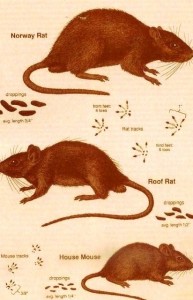Mice, Mouse Rodent Control – Minneapolis and St Paul Minnesota
Mice and rats can be found in and around every town and home in the country. It is estimated that there is one rat for every person living in the United States. Rodents have followed man to almost all parts of the world. They have no respect for social class; they are equal opportunity pests.
Mice and rats are so closely linked to man they are called domestic rodents. Man supplies their three basic needs: food, shelter, and water.
Rodents are a threat to health, and they interfere with our economic and physical well being.
- They are destructive pests and serious safety hazards.
- Rats will bite babies in their cribs, because the smell of milk or other food on the baby is attractive to a rat looking for food. A clean baby in a clean crib is a lot safer from rat attack. To protect your baby, take the bottle away as soon it’s finished, and wash its hands and face. Do the same for any disabled or elderly persons in your household who cannot care for themselves
- They start fires by gnawing on electric cables. The next time you hear the phrase “fire of unknown origin,” think about rats and mice.
- Worse, they spread disease to humans and other animals through their bite, by transporting fleas, lice, mites and ticks, and by leaving their droppings in food and other materials that humans contact. Rodents are vectors for bubonic plague, rat bite fever, leptospirosis, Hantavirus, trichinosis, infectious jaundice, rat mite dermatitis, salmonellosis, pulmonary fever, and typhus. Mice have been linked to asthma.
- They eat large amounts of food, and they contaminate even more with their urine, feces, and hair. At least 20 percent of the world’s food is eaten or contaminated by rats and mice each year.
- They damage structures, books, furniture, even appliances, through gnawing and burrowing.
- Rodents can be found in our homes, supermarkets, restaurants, livestock pens, and farm fields. Warehouses, grain mills, elevators, silos and corncribs are especially vulnerable to rodent infestation. Rodents will eat anything man or his livestock eats. They are active at night. Rats are seldom seen during the day except when populations are exceedingly large. Rats and mice can crawl through very small crevices, which make it hard to confine their movement. Even if you can’t see them, you may hear them moving after dark. If your pet paws at a wall or cabinet it may be after a lurking rodent. Cats and dogs are not much of a deterrent to rodents, however.
Usually, the first clue of a serious rodent problem is their droppings on the kitchen counter, in kitchen drawers, cabinets, or the pantry. When one dwelling is infested, it’s likely the immediate neighborhood is, too. That’s why rodents are so difficult for one homeowner to control. Rodents are a community problem. Effective control necessitates that all homeowners in a community work together to eliminate sources of food, water, and shelter. Rodents are persistent in their efforts to invade the home, but you can deal with them effectively if you know their capabilities.
For more information or to schedule an appointment for an inspection please give Minnesota Wild Management a call. They are trained to eliminating and controlling Rodent problems. For a homeowner to try and tackle this by themselves is real hard to do and usually not successful.




